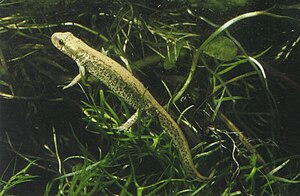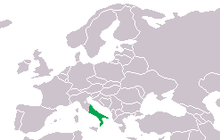Italian newt
| Italian newt | ||||||||||||
|---|---|---|---|---|---|---|---|---|---|---|---|---|

Italian newt ( Lissotriton italicus ) |
||||||||||||
| Systematics | ||||||||||||
|
||||||||||||
| Scientific name | ||||||||||||
| Lissotriton italicus | ||||||||||||
| ( Peracca , 1898) |
The Italian newt ( Lissotriton italicus , syn .: Triturus italicus see: Triturus ) is a species of amphibian from the family of the real salamanders (Salamandridae). Along with the closely related Spanish water newt ( Lissotriton boscai ), it is considered to be the most original European newt species in terms of evolutionary history.
features
It is the smallest newt in Europe. It has a total length of 60 to 80 millimeters, although 80 mm is rarely reached and the males remain slightly smaller than the females. Its head is relatively broad and small; this sometimes has an indistinct longitudinal fold in the middle and is set off from the trunk by a throat fold. A flat longitudinal groove runs along the spine, which is lined on both sides by the back gland ridges. In the males, no back crest develops during the stay in the water. The length of the tail corresponds roughly to the length of the head and torso. In both sexes, during the breeding season, it has a flat, full-edged fin edge and a short tail spine.
The top of the Italian newt is brownish and dark brown to black, while gold-colored spots with metallic sheen are present on the flanks while in the water. Behind the eye there is a light, downward lateral stripe of the head. The underside is saffron-colored to yellowish, with dark spots on the belly. The transition area between the top and bottom is white.
The caudal fin edge of the males is higher and their cloaca is more domed. They also have more pronounced back gland ridges. The dark spots on the upper side are larger and irregularly arranged in the males, in the females they are often concentrated on the flanks and form a band of spots.
During the stay on land, the tail fin fringes are greatly reduced, the metallic spots are no longer recognizable and the skin becomes water-repellent and velvety.
distribution
The Italian newt occurs in the central and southern part of Italy . The northern limit of the distribution area corresponds to an imaginary line from Ancona to Genga , through the Marche region , over the Gran Sasso d'Italia and to Formia (Monti Aurunci). It is the only water newch species that colonizes the southernmost tip of Calabria , the province of Reggio Calabria . The main focus of the distribution is probably the lowlands of southeast Italy.
habitat
During the breeding season, this heat-loving species prefers small, stagnant bodies of water. The Italian newt is often found in the smallest pools of water that periodically dry out, but also in deep and cool cisterns. He looks for damp hiding places on land, for example under stones or dead wood. During the summer, Reggio Calabria experiences a three to four month drought. The species rises on Lago Remmo in the province of Potenza to altitudes of 1525 meters, in Calabria it is the only newt species to be found below 700 meters.
Way of life
In the lowlands, the spawning waters are likely to be visited as early as the end of January. The mating behavior is similar to that of the Spanish newt, only these two species show the "flamenco position" during the courtship dance. The female later folds gray-white eggs one by one in aquatic plants. The eggs have a diameter of about 1.5 millimeters and are surrounded by an oval gelatinous shell. Embryonic development takes two to four days.
The larvae are five to seven millimeters in size when they hatch. The metamorphosis is often completed in shallow, warm waters after only four to six weeks. Then the young newts, with an average length of 26 millimeters, visit the country. In deeper and cooler cisterns the larval period can last several months. So far, no data are available on the onset of sexual maturity and age. Forms of neoteny are known in the Italian newt.
Hibernation is not mandatory, especially in the southern part of the distribution area, the animals can sometimes stay in the water all year round. In the dry periods in summer, the newts hold a summer dormancy. They are diurnal and nocturnal in water, but probably only nocturnal on land. The diet consists of different invertebrates.
The Italian newt can make low defensive noises when attacked.
literature
- Andreas Nöllert, Christel Nöllert: The amphibians of Europe . Franckh Kosmos Verlag, Stuttgart 1992, ISBN 3-440-06340-2 .
Web links
- Photos of the Italian newt at www.herp.it
- Lissotriton italicus inthe IUCN Red List of Threatened Species 2013.1. Posted by: Jan Willem Arntzen, Franco Andreone, Claudia Corti, Roberto Sindaco, Antonio Romano, 2008. Retrieved November 20, 2013.
